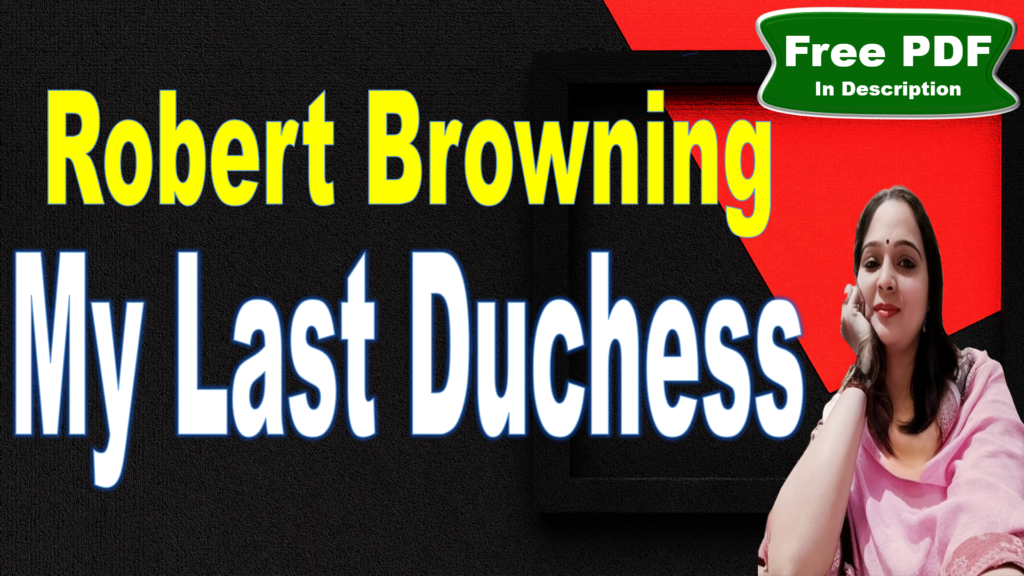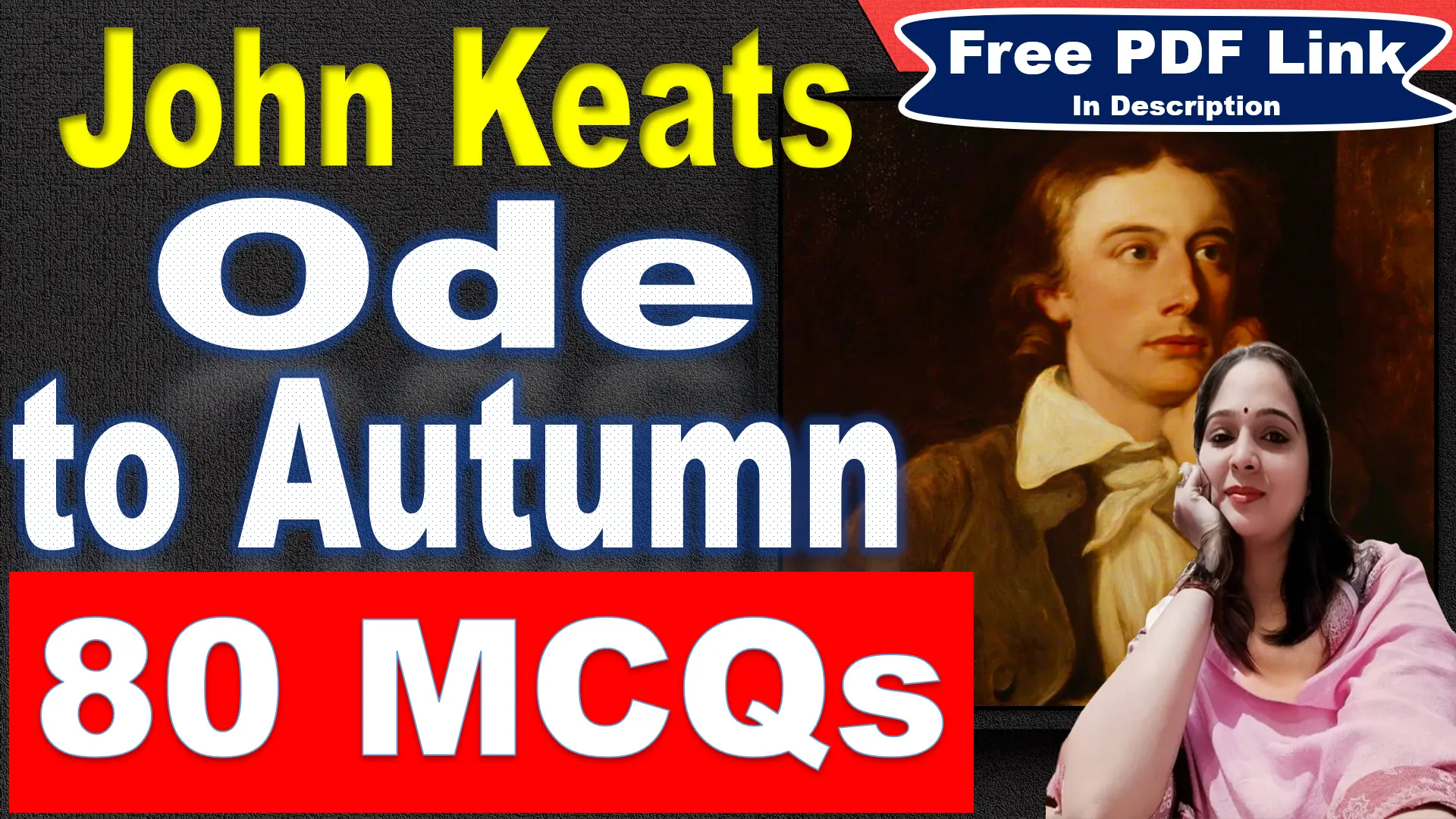
Essay Type Questions
Write the critical appreciation of the poem.
Introduction
Robert Browning’s My Last Duchess is one of the finest examples of the dramatic monologue, a poetic form where the speaker inadvertently reveals aspects of their personality while addressing someone else. Published in 1842 in Browning’s collection Dramatic Lyrics, the poem is set in Renaissance Italy and is narrated by the Duke of Ferrara, who speaks to an emissary about a portrait of his late wife, the Duchess. Through the Duke’s speech, Browning explores themes of power, control, and the objectification of women.
Central Idea
The central idea of My Last Duchess revolves around the Duke’s possessive and tyrannical nature. The poem exposes how the Duke, a man of power and status, controls and oppresses his wife, ultimately leading to her demise. His desire for control is evident in the way he treats the portrait of his deceased wife as an object he can display and hide at will. The poem critiques the abuse of power and reflects on the consequences of a patriarchal society that reduces women to mere objects of possession.
Structure & Rhyme Scheme
The poem is written in rhymed couplets, known as heroic couplets, following the rhyme scheme AA, BB, CC, and so on. The use of iambic pentameter adds a rhythmic quality to the Duke’s speech, enhancing its formal and aristocratic tone. Despite this formal structure, Browning uses enjambment extensively, allowing the Duke’s speech to flow naturally, mimicking conversation. This technique creates a contrast between the rigid form and the casual yet manipulative nature of the Duke’s speech.
Theme
The major themes of the poem include:
Power and Control: The Duke’s obsession with controlling every aspect of his wife’s life, even after her death, reveals his desire for total dominance. This is a critique of the power dynamics in relationships, especially in a patriarchal society.
Jealousy and Possession: The Duke’s jealousy is evident in his dissatisfaction with the Duchess’s behavior, as he resents the fact that she finds joy in simple things. His possessiveness leads him to view her as an object, further emphasized by his control over her portrait.
Objectification of Women: The Duke treats the Duchess as a possession, objectifying her in life and in death. The portrait becomes a symbol of how the Duke desires to control and manipulate her image, much like how he wanted to control her behavior.
Style
Browning’s style in My Last Duchess is distinct for its psychological insight and vivid character portrayal. The poem is a dramatic monologue, which allows the Duke to reveal his personality, thoughts, and actions indirectly. Browning’s use of conversational tone, historical references, and detailed imagery brings the Duke’s world to life. The Duke’s speech appears casual, but it gradually reveals his cruelty, arrogance, and obsession with control, making the reader question his moral character.
Poetic Devices
Browning employs several poetic devices to enhance the impact of the poem:
Dramatic Monologue: The entire poem is a speech by the Duke, revealing his character indirectly. The Duke’s manipulation of the conversation allows the reader to infer his darker qualities.
Irony: The Duke believes he is presenting himself as a dignified, respectable figure, but his words reveal his true nature—a jealous, controlling tyrant. This irony deepens the psychological complexity of the poem.
Imagery: Vivid descriptions such as “the faint half-flush that dies along her throat” bring the Duchess’s portrait to life and highlight the Duke’s fixation on controlling her appearance.
Symbolism: The portrait symbolizes the Duke’s desire to control and possess the Duchess. The curtain he draws over the portrait represents his ability to dictate who gets to see her, even in death.
Enjambment: The use of enjambment, where lines flow into each other without pause, mirrors the Duke’s manipulative and smooth speech, which hides his cruel intentions.
Critical Commentary
Critics have admired Browning’s psychological portrayal of the Duke, calling My Last Duchess a masterpiece of character study. Harold Bloom described the Duke as “one of the great self-revealing villains of literature,” as Browning allows the Duke’s pride, possessiveness, and moral blindness to unfold naturally through his own words. Feminist critics often highlight the objectification and control of the Duchess, viewing the poem as a critique of patriarchal attitudes towards women during both the Renaissance and Victorian eras. M.H. Abrams praised the poem for its subtle exploration of power dynamics, noting how Browning’s use of the dramatic monologue adds layers of meaning.
Message
The message of My Last Duchess is a warning against the dangers of unchecked power and control, especially in relationships. Browning critiques the way individuals can become dehumanized when they are treated as possessions, and he emphasizes the moral corruption that can result from excessive pride and jealousy. The Duke’s inability to appreciate his wife’s genuine joy and individuality leads to tragic consequences, highlighting the importance of empathy, respect, and mutual understanding in relationships.
Conclusion
My Last Duchess stands as a powerful critique of power, control, and the objectification of women. Through the Duke’s chilling monologue, Browning masterfully reveals the psychological depth of a man consumed by pride, jealousy, and the need for dominance. The poem’s timeless themes and its exploration of the darker aspects of human nature make it a classic, still resonating with readers today. Browning’s innovative use of dramatic monologue, coupled with his psychological insight, ensures that My Last Duchess remains one of the most significant works in Victorian poetry.
Long note on themes of the poem.
1. Power and Control
The Duke in the poem wants to control everyone around him, including his late wife. He shows off her portrait as a way to demonstrate his power. The painting symbolizes how he still wants to control her image and memory, even after her death. This theme shows how the Duke’s need for power extends to every part of his life.
2. Jealousy and Possession
Jealousy is a big part of the Duke’s character. He gets upset because the Duchess was equally pleased by everything and everyone, not just by him. He wanted her to only value his gifts and his status, and her enjoyment of other things made him feel insecure. This theme highlights his possessive nature and how he wants to own all of her attention and affection.
3. Art and Representation
Art is very important in the poem. The Duke talks about the portrait of the Duchess to show off his wealth and control. The painting isn’t just a picture; it’s a way for him to control how people see the Duchess and, by extension, control his own image. This theme shows how art can be used to influence and manipulate perceptions.
4. Social Status and Class
The Duke is obsessed with his social status. He mentions his old family name and his wealth to emphasize his high rank. He feels that the Duchess should have recognized his social superiority more. This theme explores how important social status is to the Duke and how it affects his relationships and behavior.
5. Hypocrisy and Self-Justification
The Duke tries to justify his actions and blame the Duchess for not valuing him enough. He criticizes her for being easily pleased, while he himself is portrayed as selfish and manipulative. This theme shows the Duke’s hypocrisy and how he tries to make himself look better by shifting the blame onto the Duchess.
6. Objectification and Dehumanization
The Duke sees the Duchess more as a possession than a person. He talks about her as if she were an object to be admired rather than a human with feelings. This theme highlights how he dehumanizes her, focusing only on how she reflects on him rather than who she was as an individual.
7. Marriage and Power Dynamics
In the poem, marriage is portrayed as a way for the Duke to increase his power and status. He treats it like a business deal, focusing on the dowry and his own gain rather than love or companionship. This theme shows how the Duke’s view of marriage is influenced by his desire for power and control.
In summary, “My Last Duchess” explores how power, jealousy, and social status affect relationships. The Duke’s actions and words reveal his need for control and his views on art, status, and marriage, showing a complex mix of emotions and motives.





